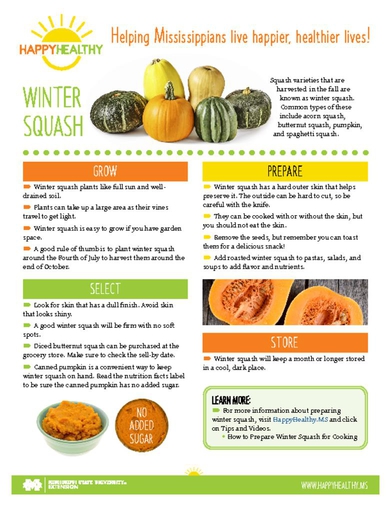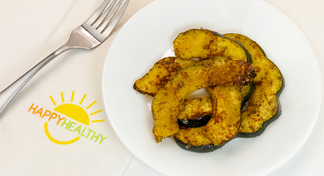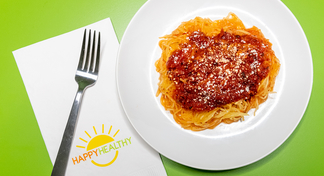Squash varieties that are harvested in the fall are known as winter squash. Common types of these include acorn squash, butternut squash, pumpkin, and spaghetti squash.
Grow
- Winter squash plants like full sun and well-drained soil.
- Plants can take up a large area as their vines travel to get light.
- Winter squash is easy to grow if you have garden space.
- A good rule of thumb is to plant winter squash around the Fourth of July to harvest them around the end of October.
Select
- Look for skin that has a dull finish. Avoid skin that looks shiny.
- A good winter squash will be firm with no soft spots.
- Diced butternut squash can be purchased at the grocery store. Make sure to check the sell-by date.
- Canned pumpkin is a convenient way to keep winter squash on hand. Read the nutrition facts label to be sure the canned pumpkin has no added sugar.
Prepare
- Winter squash has a hard outer skin that helps preserve it. The outside can be hard to cut, so be careful with the knife.
- They can be cooked with or without the skin, but you should not eat the skin.
- Remove the seeds, but remember you can toast them for a delicious snack!
- Add roasted winter squash to pastas, salads, and soups to add flavor and nutrients.
Store
- Winter squash will keep a month or longer stored in a cool, dark place.
Learn More:
- For more information about preparing winter squash, click on Tips and Videos.
SPAGHETTI SQUASH WITH TOMATO SAUCE
Ingredients
- 1 spaghetti squash
- 2 teaspoons vegetable oil
- 15- to 24-ounce can or jar of low-sodium spaghetti sauce
- grated parmesan cheese to taste (optional)
Directions
- Preheat oven to 400°F.
- Wash your hands well with soap and warm water for at least 20 seconds.
- Wash squash and cut off ends to make flat surfaces. Stand squash on one of the flat surfaces and cut in half lengthwise. If squash is too hard to cut through, place in the oven to soften (15–20 minutes). Use a knife to cut around the pocket of stringy fibers and seeds in the middle of each half and loosen, then use a spoon to remove.
- Drizzle 1 teaspoon of oil on each half of the squash and rub to coat evenly. Line a baking pan with aluminum foil and place squash halves face down on the baking pan.
- Bake for 40–60 minutes until a fork easily pierces skin of squash. Let squash sit to cool while heating tomato sauce.
- Heat sauce following package instructions. Use a fork to make spaghetti-like strands. Spoon spaghetti squash onto a plate and top with tomato sauce.
- Top with grated parmesan cheese.
- Refrigerate leftovers within 2 hours.
ROASTED ACORN SQUASH
Ingredients
- 1 acorn squash
- 2 tablespoons vegetable oil
- 1 teaspoon Italian seasoning
- 2 tablespoons grated parmesan cheese
- ½ teaspoon pepper
Directions
- Preheat oven to 400°F.
- Wash your hands well with soap and warm water for at least 20 seconds.
- Wash squash and microwave for 1 minute or place in oven for about 10 minutes to make squash easier to cut. Cut off ends to make flat surfaces. Stand squash on one of the flat surfaces and cut in half lengthwise. Remove seeds with a spoon. Flip squash halves so they lay flat and cut squash into ¼-inch strips.
- Add squash, oil, Italian seasoning, parmesan cheese, and pepper to a large plastic storage bag. Shake the bag until the squash is coated with oil and spices.
- Spread squash pieces in a single layer on a baking pan. Place pan in oven and bake for 25 minutes.
- Refrigerate leftovers within 2 hours.
Publication 3613 (POD-4-24)
By Anne Marie Gregory, Mississippi State University Extension Service.
This material was funded by USDA's Supplemental Nutrition Assistance Program - SNAP. This institution is an equal opportunity provider.
Department: Nutrition Education
The Mississippi State University Extension Service is working to ensure all web content is accessible to all users. If you need assistance accessing any of our content, please email the webteam or call 662-325-2262.







